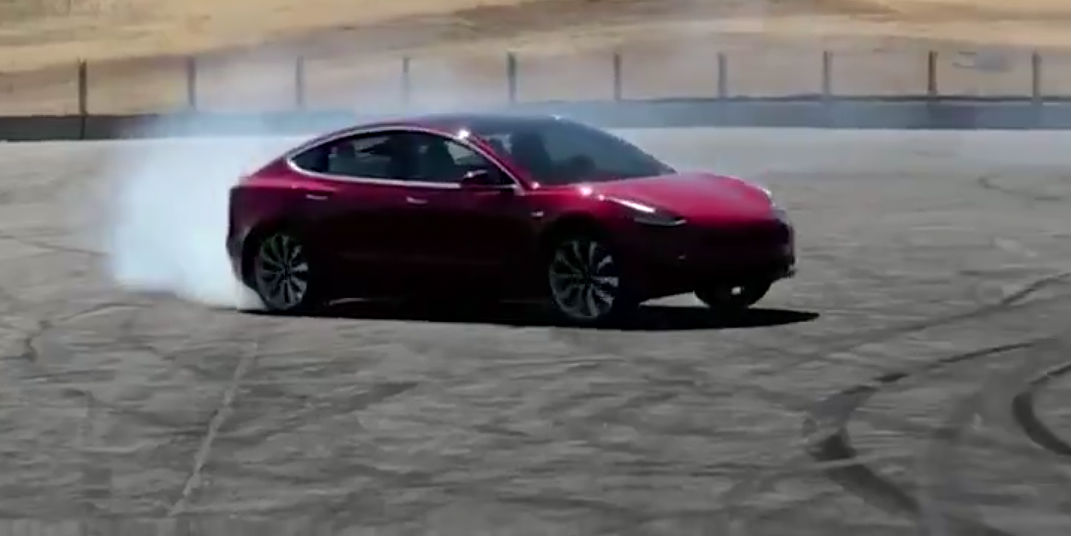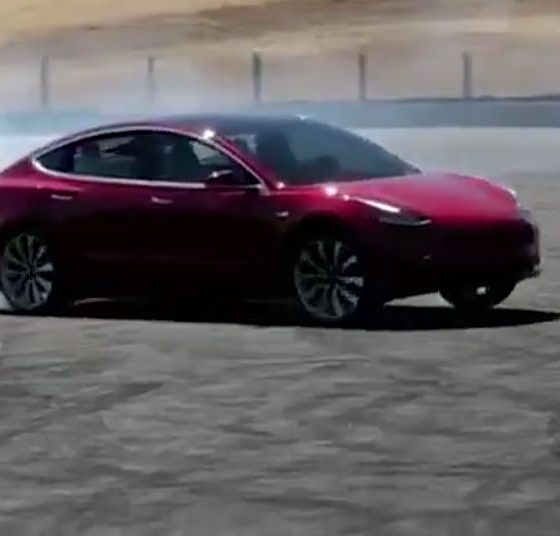

News
Tesla Model S P100D still king, but Elon Musk dubs Model 3 Performance as ‘higher value for money’
Tesla continues to actively promote the Model 3 to customers, with CEO Elon Musk recently stating that the Model 3 Performance is “higher value for money” compared to the company’s top-tier vehicle — the Model S P100D.
Musk’s latest push for the Model 3 Performance came as a response to a Model S P85D owner, who inquired if it is worth trading in his larger vehicle to the smaller but seemingly more nimble Model 3 Performance. For the first time since the Model 3’s launch, Musk compared the car favorably against the Model S P100D, at least when it comes to value for money.
Model S P100D is def still the top end, but Model 3 Performance is higher value for money
— Elon Musk (@elonmusk) August 5, 2018
In a lot of ways, Elon Musk’s statement does ring true. After all, the difference between a fully loaded Model S P100D and a fully-optioned Model 3 Performance is substantial. In Tesla’s design page, the Model S P100D is listed with an estimated cost of $135,200 with all options included. The Model 3 Performance, on the other hand, costs $80,000 fully-loaded. That’s a difference of roughly $55,000 — just slightly above the cost of a non-performance Tesla Model 3 Dual Motor AWD before any options.
This is not to say that Tesla is dissuading customers from purchasing the Model S P100D, of course. As mentioned by Musk in his tweet, the P100D is still the top end of Tesla’s offerings. With its gut-wrenching 0-60 mph time of 2.28 seconds with Ludicrous Mode, it is far quicker than the Model 3 Performance, which has a 0-60 mph time of 3.5 seconds. Nevertheless, the Model S P100D is known for severely throttling its performance when driven hard around the track — an issue that is not present in the Model 3 Performance, thanks to a clever battery and electric motor cooling system. The Model 3’s electric motors and battery use cooling circuits that are independent but linked. In the event that one component heats up, the system shifts cooling capacity where it’s needed. The system can also use the battery as a heat sink to shed excess thermal load from the motors.
Elon Musk’s latest tweet about the Model 3 Performance says a lot about the company’s strategy in the coming quarters. In the recently-held Q2 2018 earnings call, Musk and Tesla’s executives stood firm on their target of making the company profitable in the third quarter. Musk mentioned this in the call, when he linked the company’s profitability target to the Model 3 ramp.
“At a production rate of 7,000 cars a week, we believe we can be sustainably profitable from Q3 onwards. We’re going to try to raise that rate of the Model 3 production steadily in the coming quarters and try to get to the 10,000 cars a week number as soon as we can. I feel comfortable achieving a GAAP income positive and cash flow positive quarter every quarter from here on out,” Musk said.
So why the Model 3 Performance? Tesla likely makes a good amount of profit from the Model S P100D, but the full-sized sedan’s production has pretty much plateaued over the years. The Model 3 ramp, on the other hand, is still ongoing, and is expected to rise significantly in the coming quarters. Tesla is aiming to hit a gross margin of 25% for the Model 3, and with the vehicle’s production estimated to hit 10,000/week sometime next year, Tesla appears to have a solid shot at making its sustained profitability goals a reality.

News
Tesla Giga Berlin draws “red line” over IG Metall union’s 35-hour week demands
Factory manager André Thierig has drawn a “red line” against reducing Giga Berlin’s workweek to 35 hours, while highlighting that Tesla has actually increased its workers’ salaries more substantially than other carmakers in the country.

Tesla Giga Berlin has found itself in a new labor dispute in Germany, where union IG Metall is pushing for adoption of a collective agreement to boost wages and implement changes, such as a 35-hour workweek.
In a comment, Giga Berlin manager André Thierig drew a “red line” against reducing Giga Berlin’s workweek to 35 hours, while highlighting that Tesla has actually increased its workers’ salaries more substantially than other carmakers in the country.
Tesla factory manager’s “red line”
Tesla Germany is expected to hold a works council election in 2026, which André Thierig considers very important. As per the Giga Berlin plant manager, Giga Berlin’s plant expansion plans might be put on hold if the election favors the union. He also spoke against some of the changes that IG Metall is seeking to implement in the factory, like a 35-hour week, as noted in an rbb24 report.
“The discussion about a 35-hour week is a red line for me. We will not cross it,” Theirig said.
“(The election) will determine whether we can continue our successful path in the future in an independent, flexible, and unbureaucratic manner. Personally, I cannot imagine that the decision-makers in the USA will continue to push ahead with the factory expansion if the election results favor IG Metall.”
Giga Berlin’s wage increase
IG Metall district manager Jan Otto told the German news agency DPA that without a collective agreement, Tesla’s wages remain significantly below levels at other German car factories. He noted the company excuses this by referencing its lowest pay grade, but added: “The two lowest pay grades are not even used in car factories.”
In response, Tesla noted that it has raised the wages of Gigafactory Berlin’s workers more than their German competitors. Thierig noted that with a collective agreement, Giga Berlin’s workers would have seen a 2% wage increase this year. But thanks to Tesla not being unionized, Gigafactory Berlin workers were able to receive a 4% increase, as noted in a CarUp report.
“There was a wage increase of 2% this year in the current collective agreement. Because we are in a different economic situation than the industry as a whole, we were able to double the wages – by 4%. Since production started, this corresponds to a wage increase of more than 25% in less than four years,” Thierig stated.
News
Tesla is seeing a lot of momentum from young Koreans in their 20s-30s: report
From January to November, young buyers purchased over 21,000 Teslas, putting it far ahead of fellow imported rivals like BMW and Mercedes-Benz.

Tesla has captured the hearts of South Korea’s 20s-30s demographic, emerging as the group’s top-selling imported car brand in 2025. From January to November, young buyers purchased over 21,000 Teslas, putting it far ahead of fellow imported rivals like BMW and Mercedes-Benz.
Industry experts cited by The Economist attributed this “Tesla frenzy” to fandom culture, where buyers prioritize the brand over traditional car attributes, similar to snapping up the latest iPhone.
Model Y dominates among young buyers
Data from the Korea Imported Automobile Association showed that Tesla sold 21,757 vehicles to the 20s-30s demographic through November, compared to BMW’s 13,666 and Mercedes-Benz’s 6,983. The Model Y led the list overwhelmingly, with variants like the standard and Long Range models topping purchases for both young men and women.
Young men bought around 16,000 Teslas, mostly Model Y (over 15,000 units), followed by Model 3. Young women followed a similar pattern, favoring Model Y (3,888 units) and Model 3 (1,083 units). The Cybertruck saw minimal sales in this group.
The Model Y’s appeal lies in its family-friendly SUV design, 400-500 km range, quick acceleration, and spacious cargo, which is ideal for commuting and leisure. The Model 3, on the other hand, serves as an accessible entry point with lower pricing, which is valuable considering the country’s EV subsidies.
The Tesla boom
Experts described Tesla’s popularity as “fandom culture,” where young buyers embrace the brand despite criticisms from skeptics. Professor Lee Ho-geun called Tesla a “typical early adopter brand,” comparing purchases to iPhones.
Professor Kim Pil-soo noted that young people view Tesla more as a gadget than a car, and they are likely drawn by marketing, subsidies, and perceived value. They also tend to overlook news of numerous recalls, which are mostly over-the-air software updates, and controversies tied to the company.
Tesla’s position as Korea’s top import for 2025 seems secured. As noted by the publication, Tesla’s December sales figures have not been reported yet, but market analysts have suggested that Tesla has all but secured the top spot among the country’s imported cars this year.
News
Tesla FSD fleet is nearing 7 billion total miles, including 2.5 billion city miles
As can be seen on Tesla’s official FSD webpage, vehicles equipped with the system have now navigated over 6.99 billion miles.

Tesla’s Full Self-Driving (Supervised) fleet is closing in on almost 7 billion total miles driven, as per data posted by the company on its official FSD webpage.
These figures hint at the massive scale of data fueling Tesla’s rapid FSD improvements, which have been quite notable as of late.
FSD mileage milestones
As can be seen on Tesla’s official FSD webpage, vehicles equipped with the system have now navigated over 6.99 billion miles. Tesla owner and avid FSD tester Whole Mars Catalog also shared a screenshot indicating that from the nearly 7 billion miles traveled by the FSD fleet, more than 2.5 billion miles were driven inside cities.
City miles are particularly valuable for complex urban scenarios like unprotected turns, pedestrian interactions, and traffic lights. This is also the difference-maker for FSD, as only complex solutions, such as Waymo’s self-driving taxis, operate similarly on inner-city streets. And even then, incidents such as the San Francisco blackouts have proven challenging for sensor-rich vehicles like Waymos.
Tesla’s data edge
Tesla has a number of advantages in the autonomous vehicle sector, one of which is the size of its fleet and the number of vehicles training FSD on real-world roads. Tesla’s nearly 7 billion FSD miles then allow the company to roll out updates that make its vehicles behave like they are being driven by experienced drivers, even if they are operating on their own.
So notable are Tesla’s improvements to FSD that NVIDIA Director of Robotics Jim Fan, after experiencing FSD v14, noted that the system is the first AI that passes what he described as a “Physical Turing Test.”
“Despite knowing exactly how robot learning works, I still find it magical watching the steering wheel turn by itself. First it feels surreal, next it becomes routine. Then, like the smartphone, taking it away actively hurts. This is how humanity gets rewired and glued to god-like technologies,” Fan wrote in a post on X.








